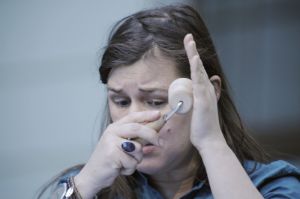Concert | John Cage 100 / Recital
DREAM Early Songs & Piano Piano Pieces by John Cage
DREAM
Early Songs & Piano Pieces by John Cage

Natalia Pschenitschnikova © Kai Bienert
The artist and interpreter Natalia Pschenitschnikova and the pianist Alexej Lubimov, who is especially well-known for seeing to Cage’s reception in eastern Europe, present early songs and piano works by John Cage in a diverse programme. They are proof of the composer’s roots as well as his rich ingenuity and artistic avowals.
Impressed by Erik Satie (1866-1925), Cage wrote many simple piano and vocal works that were reduced to only one melody, such as the Prelude for Meditation (1944), Experiences II (1948) and Dream (1948) for the dance pieces of his later partner, Merce Cunningham.
He also radically continued the piano manipulations of his teacher Henry Cowell (1897-1965) by using everyday instruments such as nails and bolts. John Cage’s first composition for a prepared piano, Bacchanale (1940), an accompanying piece to Syvilla Fort’s dance work, replaced an entire drum ensemble that was too large for the theatre hall but that Cage had wanted for his work. At the same time, he “desecrated” the piano.
And he wrote the charming and lyrical song, The Wonderful Widow of Eighteen Springs, based on a text from Finnegans Wake by James Joyce (1882-1948) a year after the author’s death. A mysterious piece, in which the pianist accompanies the pure and vibrato-free sound of the voice with knocking rhythms against, on and under the closed piano. Not a single piano note is played.
Marcel Duchamp (1887-1968) was John Cage’s role model regarding how to live without a role model and how one should initially view things as they are – ready made. Cage shared many of Duchamp’s views and, in a certain way, he created numerous musical ready mades, alone, in which music was liberated from its deceptive intimacy and the sound from its subject.
John Cage composed the rhythmical study Music for Marcel Duchamp (1947) for a film sequence that Duchamp made for Dreams That Money Can Buy, the legendary experimental film by Hans Richter. For this music, Cage used only a few sounds from a prepared piano and, for the first time, he also included silence in the rhythmical structure of the work.
Dream
for piano (1948)
Experiences No. 2
for solo voice, text: e. e. cummings (1948)
Music for Marcel Duchamp
for prepared piano (1947)
Three Songs
for voice and piano
Text: Gertrude Stein (1933)
The Unavailable Memory of
for prepared piano (1944)
She is Asleep
for voice and prepared piano(1943)
A Room
for prepared piano (1943)
Five Songs for Contralto
for mezzo-soprano and piano
Text: e. e. cummings (1938)
Bacchanale
for prepared piano (1940)
The Wonderful Widow of Eighteen Springs
for voice and piano
Text: James Joyce (1942)
Nowth upon Nacht
for voice and piano
Text: James Joyce (1984)
Prelude for Meditation
for prepared piano (1944)
A Flower
for voice and (closed) piano (1950)